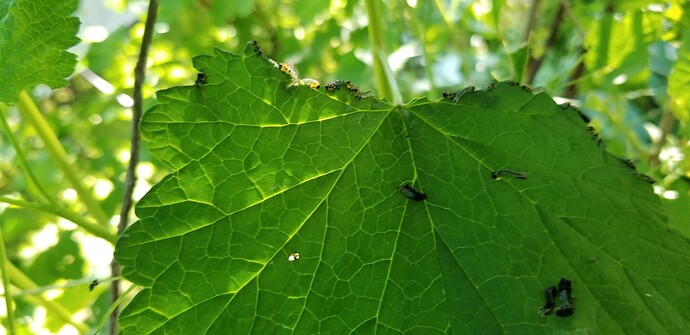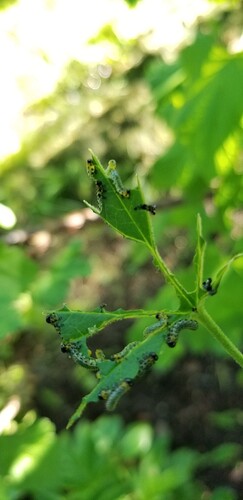What are these and how do I get rid of them?
They start on our maple every spring and eat every leaf then go to the currant below.
I’ve been squishing them to cut down their number but they seem to come back. I tried a soap oil spray mix but that doesn’t seem to deter them.
As near as I can see in your photos, the larvae resemble those of the imported currantworm, Nematus ribesii. A little surprising they are eating the maple leaves as they are species specific eaters of plants in the Genus Ribes.
To tell if the larvae are sawfly instead of a caterpillar species, put one in a small container and place it in the fridge for 10-15 minutes. Grab a magnifying glass and check the number of prolegs on the larvae. If there are 6 pairs and there are no hooks at the tips, it is a sawfly species. (Caterpillar species only have 3 pairs of hooked prolegs.)
Sawflies are difficult to eradicate because they pupate in the soil and adult females lay their eggs on the underside of the leaves…inserting them into the tissue along the midrib and veins. Difficult area to reach with an oil spray. The eggs are typically laid when the leaves are nearing full spread. Larvae emerge in 7 to 10 days and eat their way through 5-6 instar stages. Takes 2-3 weeks for this growth period. Then they drop to the ground, burrowing into the soil to pupate.
The unfortunate part about this pest species is some of those pupating sawflies will emerge in June or July as adults to lay more eggs. Damage is not usually quite so heavy on the foliage with this generation due to reduced numbers. But, weather conditions being favourable, there could be a third generation of adults emerging in August. The remainder of the pupating first generation seem to be content to wait through the winter before they emerge, along with the 2nd and 3rd generations…if there was a 3rd.
As I wrote in my last Duchess of Dirt column, I seem to have had good success on controlling the azalea sawfly infestation which has been plaguing our deciduous azaleas for the past 5 years or so by pouring my soapy dishwater underneath the shrubs. By now, I should be seeing the larvae but spot checks conducted have revealed no pests. I remain hopeful.
Keep squishing your larvae and once the rest have disappeared, pour soapy water around the tree and bushes every 7-10 days. (About 1 tbsp of soap to 2 gallons of water.) This may reduce the number of emerging 2nd generation adults. Also, do not trap and kill European paper wasps or yellow jackets. They are voracious predators of sawfly and other soft-bodied larvae…as are spiders. I worked right beside many of these predators as I squished our sawfly larvae. Never got stung but the jumping spiders challenged me if I got too close to their prey.
Best of luck!!
Great answer Leslie. There seem to be so many wormy things out right now, some particularly interested in our plum trees. I’ll have to try your technique to figure out what they are. Thanks for the helpful advice 
Thanks for taking the time to write such a detailed response.
They’re a pretty frustrating thing to deal with and the squishing is not for the faint of heart. I spent 2 days squishing the whole bush, emerging covered with them on my shirt. They seem to have stopped most of their work so I guess I caught them at the right time although by the end I had decided to let them have have the bush if they persisted.
I’ll try the soapy water at the base. Wonder if I should do that next spring as well to offset the first wave?
I did soak the bush after the first days carnage with a soap oil water solution but they didnt seem to notice my effort.
I also tried shaking the bush as recommended on the internet but more berries fell than bugs 
Thanks again for your help
Yes, good work Leslie. And I agree about the maple- very odd. Because they come from the soil, they start their carnage from the bottom and work up the shrub.
I battled these for years, and finally gave up, taking the currents and gooseberries out. Sigh.
However, I did find dropping them in a large mouthed container with quite a strong vinegar water solution was a much more palatable way of dispatching them…could drop a handful in at a time, and occasionally put the lid on and swirl it around to capture the odd one that was trying to make a break for it.
Good luck with them.
Update:
I thought my 3 squishing sessions had stopped the infestation for the moment but I checked back yesterday and they’ve come back in force and are literally eating through my bush.
I’ve lost my appetite for sqishing them so I guess I’ll let them est the whole bush. Too bad but I hope they leave the currants.

